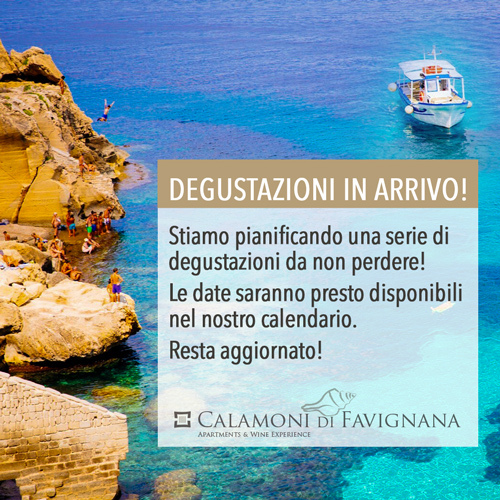The Calamoni Estate
Is located on the central-southern side of the island, just a short distance from the sea, and on the narrowest part of the strip of land overlooking the coast of Marsala, dominated by the island’s tall promontory.
Is located on the central-southern side of the island, just a short distance from the sea, and on the narrowest part of the strip of land overlooking the coast of Marsala, dominated by the island’s tall promontory.
The vineyard covers just over 5 hectares, enclosed by the traditional dry stone walls that also characterize the rural landscape of the Aegadian Islands.From the longest side of the Calamoni estate, overlooking the perimeter road, the sea is less than 10 metres away from the first vines. A marine environment, emerged lands rich in fossils. The deep red colour bears witness to the prevalence of iron. The soil here is truly unique. The island of Favignana offers a unique and one-of-a-kind habitat. Most of the Mediterranean islands are volcanic or granitic in nature.
However, the soil at the Calamoni estate consists of a platform of Quaternary limestone, formed under the sea over millions of years and composed of fossils: shells or fish bones sedimented and absorbed by the pressure that the sea exerts on the seabed. The land is open to the wind, which blows constantly from the sea, in breezes or stronger gusts, towards this strip of land. The land contains four chiuse (Italian term meaning enclosures), clearly visible to the expert eye. The enclosures were formed when the land was cleared of stones and the rocky outcrops were broken up and arranged along the perimeter.
However, the soil at the Calamoni estate consists of a platform of Quaternary limestone, formed under the sea over millions of years and composed of fossils: shells or fish bones sedimented and absorbed by the pressure that the sea exerts on the seabed. The land is open to the wind, which blows constantly from the sea, in breezes or stronger gusts, towards this strip of land. The land contains four chiuse (Italian term meaning enclosures), clearly visible to the expert eye. The enclosures were formed when the land was cleared of stones and the rocky outcrops were broken up and arranged along the perimeter.
The earth contained within the enclosures was cultivated, predominantly with wheat. Vineyards were present on the Aegadian Islands since the beginning of the twentieth century, after which they disappeared. Firriato has rekindled history by reintroducing vines into what is seemingly one of the less hospitable places for them to grow. The sea plays a fundamental role in determining the choices made with regard to cultivation and agronomic management of the vineyard on Favignana. The microclimate created that characterises the island of Favignana has a considerable effect on the vegetative-productive cycle of the plants. Continua
The chemical and physical composition of the soil, the presence of salt water just two metres below the surface, the play of wind and the effect on daytime and nighttime temperatures, make this a truly extraordinary production environment. Environmental factors that we must interact with, understanding how they interact and the effects they can have on the vines planted. This extreme viticulture faces all of the difficulties inherent to an environment so heavily characterised by the presence of the sea, but it is also enriched by them and enhances the unique features and influences exerted by this habitat.



Scrivici su WhatsApp